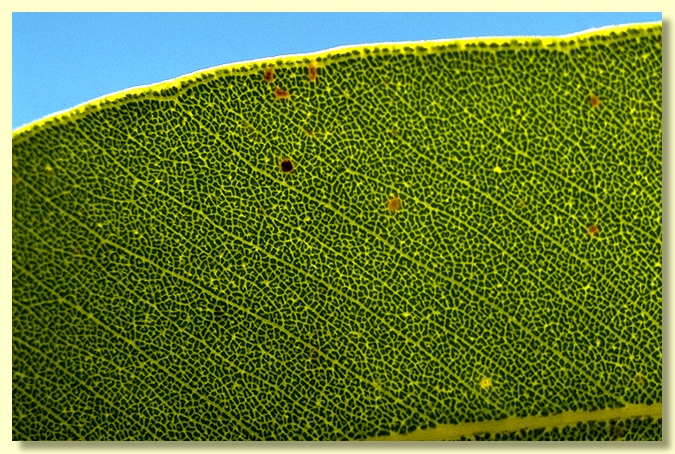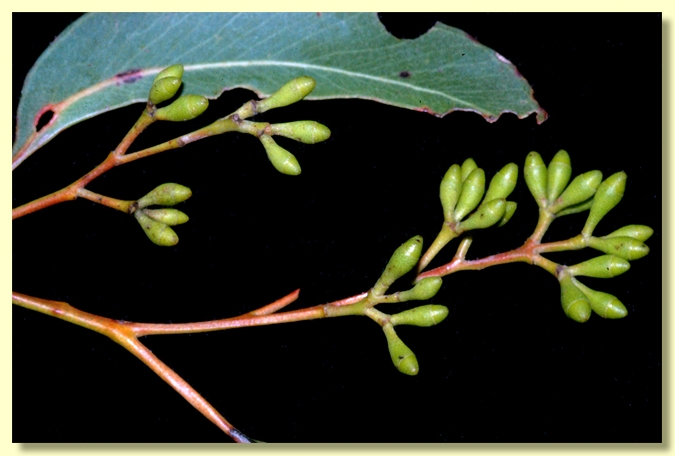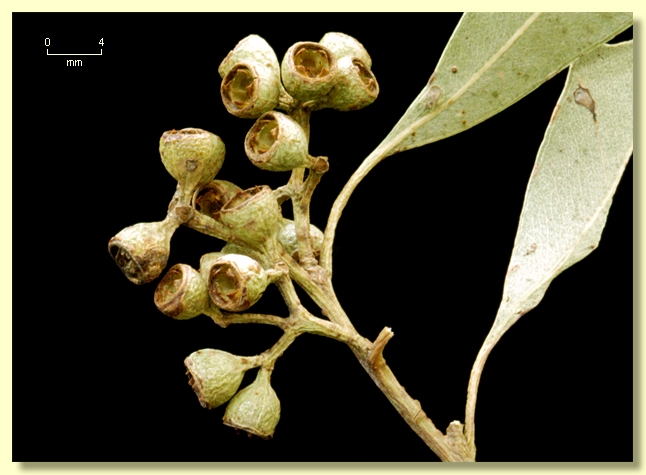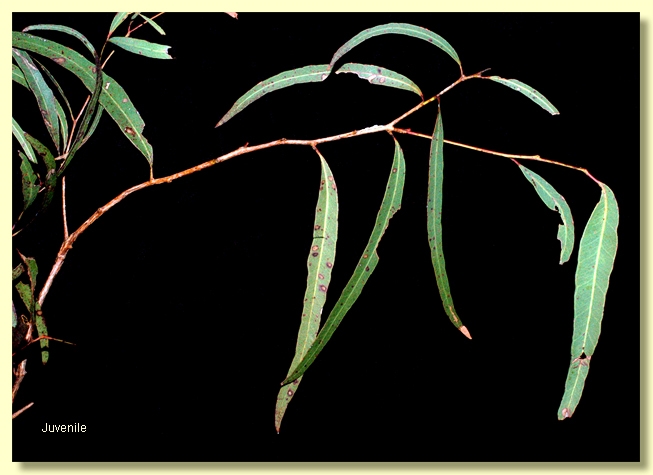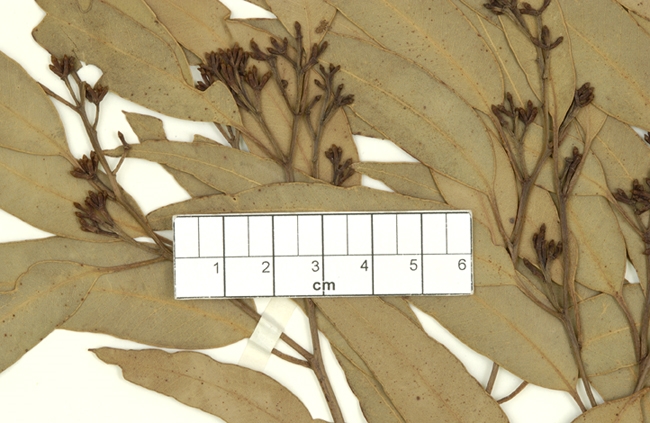Eucalyptus | Symphyomyrtus | Adnataria | Terminales | Rhodoxylon | Discolores
Euclid - Online edition
Eucalyptus decolor
Tree to 25 m tall. Forming a lignotuber.
Ironbark on the trunk and larger branches, dark grey, hard and deeply furrowed longitudinally. Small to medium sized branches with white to pink to coppery smooth bark.
Juvenile growth (coppice or field seedlings to 50 cm): stem square in cross-section; juvenile leaves always petiolate, opposite for ca 2 nodes then becoming alternate, narrowly lanceolate, 9.7–13.5 cm long, 0.7–1.6(2) cm wide, base tapering, slightly discolorous, green.
Adult leaves alternate, petiole 1–2 cm long; blade lanceolate to falcate, 6.5–13(17) cm long, 0.8–2.2 cm wide, base tapering to petiole, discolorous, dull, green, side-veins greater than 45° to midrib, very densely reticulate, intramarginal vein parallel to and very close to the margin, oil glands intersectional or obscure.
Inflorescence terminal compound, peduncles 0.6–1.5 cm long, buds 7 per umbel, pedicels 0.2–0.3 cm long. Mature buds fusiform to diamond-shaped, ca 0.4 cm long, 0.2–0.3 cm wide, scar present, operculum conical, narrower than the hypanthium at the join, stamens inflexed, with outer staminodes, anthers adnate, positioned obliquely at filament tip, cuboid, dehiscing by terminal pores, style long, stigma pin-head shaped, locules 4 or 5, the placentae each with 4 vertical ovule rows. Flowers white.
Fruit pedicellate (pedicels 0.1–0.4 cm long), truncate-ovoid to truncate-globose to hemispherical or cup-shaped, 0.4–0.5 cm long, 0.4–0.6 cm wide, disc descending, valves 4 or 5, valve tips near rim level or enclosed.
Seeds brown, 1.2–2 mm long, flattened-ovoid, dorsal surface shallowly reticulate, hilum ventral.
Cultivated seedlings (measured at ca node 10): cotyledons small, reniform; stems square in cross-section; leaves always petiolate, opposite for 4–7 nodes then alternate, lanceolate, 5.4–8 cm long, 1.3–1.5 cm wide, base tapering, dull, green, discolorous.
Flowering time recorded by Brooker & Kleinig (1994) as December to March.
A small to medium-sized ironbark tree known only from a few small populations in south-east Queensland, preferring hills and the mountainous country from the Many Peaks Range north-west of Miriam Vale to the Coast Range south of Biggenden. Characterised by the distinctly smooth-barked medium-sized branches, the adult leaves distinctly discolorous and dull green, terminal inflorescences, buds with inflexed stamens with the outermost stamens infertile (staminodes), fruit with four or five valves and narrowly lanceolate juvenile leaves.
Eucalyptus decolor is closely related to E. placita, E. paniculata and E. sp Dorsiventralis,all four species having distinctly discolorous adult leaves and belonging to the subseries Discolores. Within this group, E. decolor is closest to E. paniculata and differs marginally by having the medium-sized branches distinctly smooth-barked (usually rough-barked in E. paniculata), dull green adult leaves (E. paniculata glossy green) and slightly smaller seedling leaves to 1.8 cm wide (2–4.5 cm in E. paniculata). E. placita differs by having much broader, very glossy green juvenile leaves (up to 6 cm wide in E. placita and up to 1.8 cm wide in E. decolor). E. sp. Dorsiventralis differs by having larger buds and fruit, with buds and fruit distinctly four-sided (fruit in E. sp. Dorsiventralis 0.6–1 cm wide and 0.4–0.6 cm in E. decolor).
Eucalyptus decolor is the only ironbark in Queensland with distinctly discolorous adult leaves. All other ironbarks in Queensland normally have concolorous adult leaves. However, within its area of occurrence, E. dura, E. melanoleuca and E. suffulgens can sometimes have slightly discolorous adult leaves and therefore may be confused with E. decolor. Both E. suffulgens and E. melanoleuca can be separated by having glossy adult leaves (E. decolor normally dull). E. melanoleuca can be further separated by having ovate juvenile leaves, usually narrowly lanceolate in E. decolor. E. dura can be separated by having broadly lanceolate to ovate juveniles, usually 3–6 cm wide and narrowly lanceolate in E. decolor, usually to 1.8 cm wide.
MORE ABOUT IRONBARKS
Eucalyptus decolor: Latin decolor, discoloured or faded, referring to the adult leaves which are paler on the underside.



